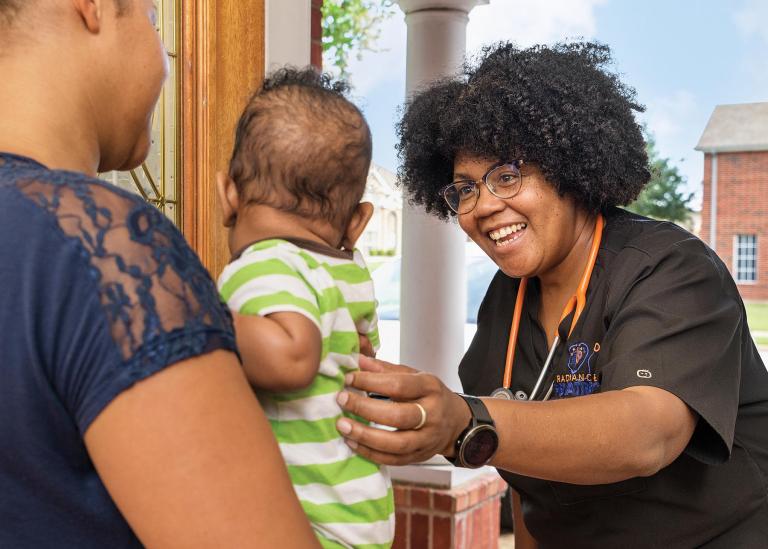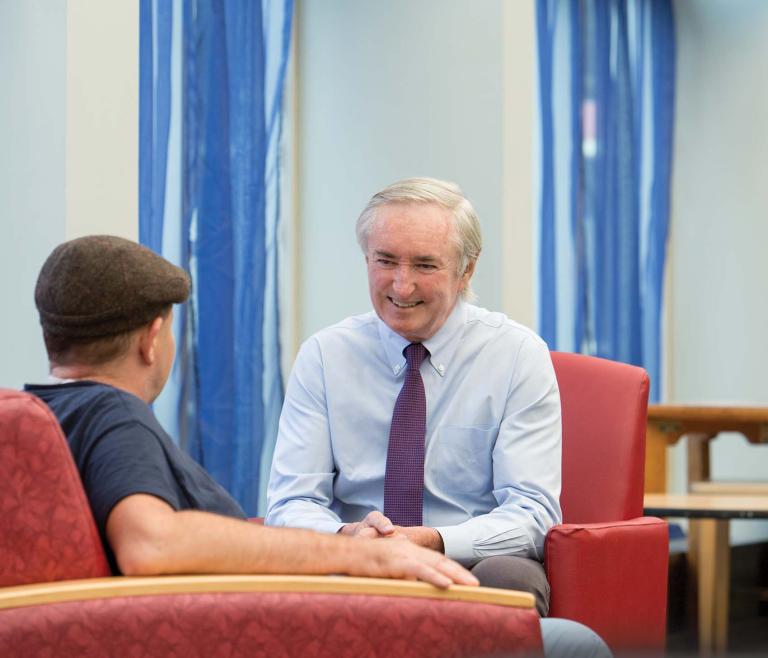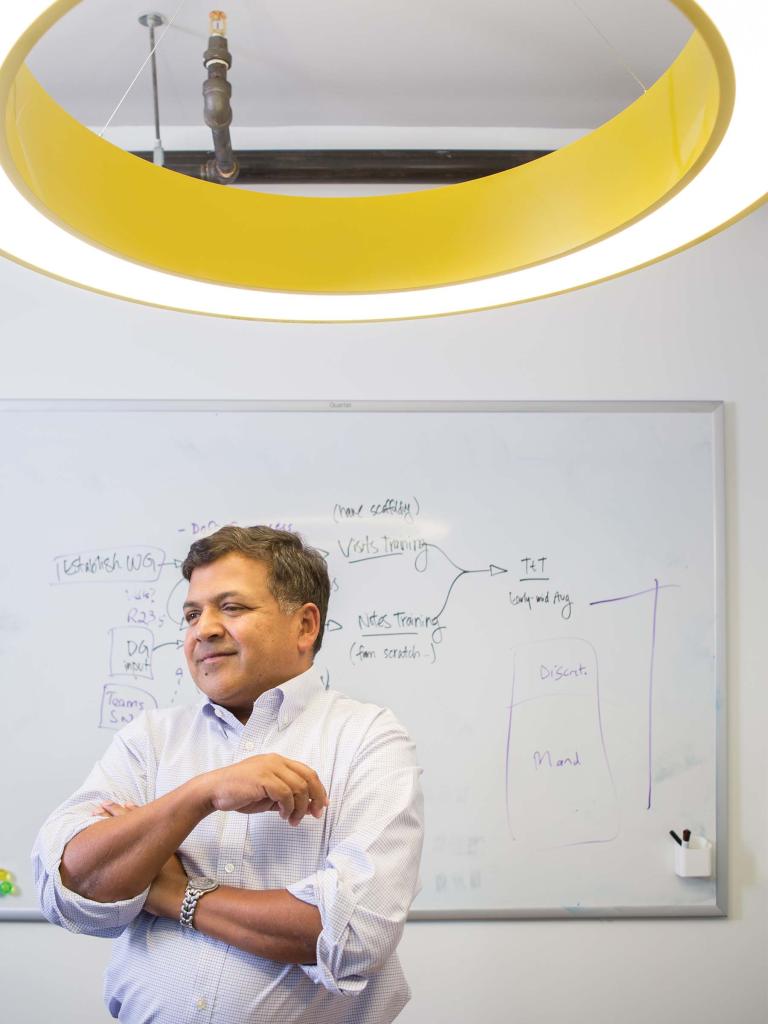The New Black Bag
Many are flummoxed over how to improve health care delivery. But for some doctors, the answer is clear—meet patients where they are
The Business of Medicine Issue
- Feature

It’s a sweltering summer morning outside Dallas, and the doctor’s bag weighs heavy as the physician stands on the porch, waiting for the door to open. When it does, she’s greeted with wide smiles from her three young patients and their mother. They welcome her inside, hand her a glass of water, and clear a place at the table. Over the next two hours, the pediatrician checks the children’s vitals, conducts physical exams, and writes any necessary prescriptions. She catches up with the family, too, listening intently to the details of their lives and plans for the coming school year. When she departs, the goodbyes are like those to an old friend.

Today, such a scenario seems quaint. But for Tonya McDonald, MD ’98, it’s business as usual. This past spring, she opened Radiance Pediatrics, a direct primary care practice that provides in-home and virtual pediatric care to families who pay a flat monthly fee. For this fee, families get extended visits, same- or next-day appointments, telemedicine visits, and direct access to McDonald through phone, text, and email.
“In some ways, this is a throwback, an old-school approach to medicine,” she admits. “But it gives me the opportunity to help rebuild the doctor-patient relationship. It’s a gift to be able to truly bond with families.”
Not long ago, McDonald was part of the 78 percent of U.S. physicians struggling to cope with burnout, a problem some have labeled a public health crisis.
“In the past five years, I was seeing up to thirty children a day, feeling sad that I couldn’t practice medicine the way I wanted,” McDonald says. “Insurance dictated what I could do.”
McDonald knew it was time for a change. And she’s far from alone.
“People point to our salaries as an issue,” says Rushika Fernandopulle, MD ’94, “but the real problem is that the job of primary care itself can be awful. Until we fix that, no amount of money will matter.”
For Fernandopulle, founder and CEO of team-based primary care provider Iora Health, that means rebuilding the field.
“Imagine that it’s 1902 and we want to get from Boston to London in a day and all we have are ships,” he muses. “We need a plane, but you can’t just slap wings on a ship.”
“Incremental change hasn’t worked,” he adds.
Then, like McDonald and others working in primary care today, Fernandopulle gets to the heart of the matter, “Let’s stop making excuses and build what we know primary care should be.”
Patients’ voices
Even as physicians like McDonald and Fernandopulle find themselves at the forefront of an evolving field, they acknowledge that much of the transformation in primary care is being driven by patients themselves. Dissatisfied with long waits, short appointments, and inadequate access to physicians, patients are voting with their feet and increasingly moving their care to models that prioritize wellness, relationships, and continuity.
Giving patients a voice—and listening to that voice—might seem faddish, but for some physicians, this has been the norm for decades. It’s an approach that James O’Connell, MD ’82, learned early in his career working with Boston’s homeless population.
Imagine that it’s 1902 and we want to get from Boston to London in a day and all we have are ships. We need a plane, but you can’t just slap wings on a ship.
As the first doctor for the nonprofit Boston Health Care for the Homeless Program, O’Connell quickly discovered that many of the qualities he was taught to value, like speed and efficiency, had to be tossed out the window. To gain his patients’ trust and respect, O’Connell needed to meet them where they were—usually literally—and establish solid relationships.
“This population hated people like me, who were there to ‘do good’ for a year and move on,” he says. “They wanted what we all look for in a doctor: Someone to form a relationship with over time.”

Nearly four decades later, O’Connell says his patients continue to drive the conversation about what primary care means, whether that’s being on call for late-night visits on the street or ensuring continuity of services after a patient receives housing. For the men and women O’Connell sees, these are needs born of the realities of living on the street. In some ways, those needs mirror the shortfalls of primary care as a whole.
“The homeless population will show you the weaknesses in the traditional health care system without even trying,” he says. “They continue to teach us how we’ve been doing things wrong.”
Giving patients a say in care delivery is also integral to Sonya Shin’s work with the Navajo Nation. Shin, MD ’98, is an HMS associate professor of medicine at Brigham and Women’s Hospital and the director of Community Outreach and Patient Empowerment (COPE), which is part of a joint tribal–Indian Health Services effort to address health disparities in the Navajo Nation. In the decade since its inception, COPE has strengthened relationships between physicians and community health representatives (CHRs), who are public health workers and members of the Navajo Nation community. COPE has also created a team approach to primary care for its patients, many of whom live in poverty and have diagnoses of chronic conditions such as diabetes and cardiovascular disease.
The citizen-patients of Navajo Nation aren’t afraid to voice their opinions about health care, and they have the means for doing so. A number of programs, including patient and family advisory councils, allow patients to meet with tribal elders, executive leadership, and clinicians to advocate for quality care. Their insight, says Shin, has helped improve communication between physicians and CHRs.
“It takes a lot of time to work with the community and build trust; we can’t just give lip service to their needs,” she explains. “Our providers are grateful for the patients who have really thought about the changes that need to be made in care delivery.”
Group practice
Making primary care a team-based endeavor is one significant change.
In the Navajo Nation, where patients with chronic diseases may see a physician only every six to 12 months, CHRs have been a critical part of primary care delivery since the 1960s. There had been, however, a disconnect when it came to ensuring that physicians and CHRs were keeping each other in the loop regarding patients’ health.
“Doctors work at hospitals; CHRs work within the community,” says Shin. “They were practicing in separate spheres.”
The homeless population will show you the weaknesses in the traditional health care system without even trying. They continue to teach us how we’ve been doing things wrong.
To address this disconnect, Shin and her colleagues at COPE began mapping the care process, implementing electronic health records for referral and CHR documentation, and creating teaching materials to train physicians and CHRs to work together for patients.
The approach has paid off. A 2017 study published in BMC Public Health found that more than 80 percent of CHRs felt strongly that COPE trainings were useful, while nearly 45 percent believed that communication and teamwork had improved because of COPE’s initiatives. What’s more, early data suggest that enhanced interaction between clinicians and CHRs may be linked to better outcomes in patients, including improved lipid profiles and A1c values.
CHRs and health coaches also play an important role in primary care at Fernandopulle’s Iora Health. At the provider’s practices throughout the United States, patients receive care not only from a physician but also from a team of professionals that includes community-based health coaches, behavioral health specialists, social workers, and nurses. According to Fernandopulle, patients who visit an Iora practice—intentionally kept small and situated in accessible locations such as strip malls—are met by a dedicated greeter before being seen by all members of their core health care team in one visit. After a patient visits, the team huddles and discusses next steps for helping that patient achieve their health and wellness goals. That might mean providing clinical advice, involving a support group, or recommending specialty care.
“We can’t just tell patients what to do,” says Fernandopulle. “We need to help them develop a plan and execute it.”
At Iora, health coaches perform outreach, working with patients in their community to improve adherence to treatment and address such social determinants of health as access to healthy food, safe public spaces, transportation, and other environmental factors that influence health and perpetuate health inequities.
Fernandopulle recalls an older woman who had moved to a new city and lacked a car. Worried about being a burden on her family, she isolated herself by staying at home, and she became sedentary, which worsened her diabetes.
In an Iora team huddle, her physician asked if she needed a higher dose of medication.
“No,” her coach replied, “she needs to get more engaged.”

Her coach taught the patient how to take public transportation and encouraged her to join a local social group. With time, her blood-sugar levels improved.
Such results are impressive to clinicians but not necessarily to insurance companies in the traditional fee-for-service system. “There’s no CPT code for ‘teach patient to ride the bus,’” Fernandopulle says ruefully. “So in most practices, no one thinks of doing this—even if it’s the right thing to do.”
People power
By placing primary care at the top of the funnel, Fernandopulle hopes that Iora will shift the current specialty-driven power dynamic in medicine.
“We think that primary care is the best platform for fixing health care as a whole because it’s closest to the consumer,” he says. “We can help patients upstream by encouraging them to eat better and exercise and downstream by helping them navigate choosing a specialist. When you flip the model, primary care now becomes the center of the health care system.”
Access to specialists is getting a makeover, too. Traditionally accomplished through referrals and marred by lengthy wait times, seeing a specialist can be fraught with frustration. Companies like InfiniteMD, co-founded by Elizabeth Kwo, MD ’09, who is also the company’s chief medical officer, are seeking to change that, relying on telemedicine to offer patients virtual second-opinion consultations with specialists. The service, available worldwide to people who self-pay or whose employers provide the service, allows patients to video chat with top-ranked oncologists, neurologists, pediatricians, and other specialists.
“Physicians don’t have the capacity to see hundreds of patients a day, but you can streamline that process by having patient coordinators work with patients to review their records and help them winnow their concerns to just five questions,” says Kwo. By paying specialists for their time directly, the company moves its customers to the front of the line, giving them the opportunity to gain medical insights quickly.
“Getting specialists to weigh in on complicated cases can be really helpful for patients and for community doctors,” she says. “We’ve had cases where our specialists have led people to better treatment or helped them access clinical trials.”
Support systems
Any changes in health care delivery generate the question of who pays. For now, the answer depends on the model—and the differences can be notable.

The model that O’Connell describes is “the other side of concierge medicine.” That means allowing for an on-call, no-appointment system in which a clinician’s hospital affiliation automatically makes homeless people patients of that clinician’s hospital, even if they never set foot inside it. About three-quarters of the caregiving costs for patients of Boston Health Care for the Homeless are covered by Medicaid, with the remainder coming from grants and philanthropic support.
“When people live on the streets, they end up subjugating their health care needs to simply trying to stay alive,” O’Connell says. “They come to the emergency department when they’re very sick. If we want to provide ongoing care of chronic diseases, we need to go to them.”
Iora Health partners with companies to make its services available to employees; Medicare Advantage patients also make up a large portion of its population. But it began as essentially a direct-care model, in which people pay about $40 a month for team-based primary care services. “The current health care system is all about transactions, but when did transactions ever heal people?” says Fernandopulle. “We want to stop the madness of fee-for-service reimbursement and the games that go with that.”
Radiance Pediatrics is also a direct-care model but one that eschews insurance altogether. McDonald does, however, encourage parents to carry some form of coverage, such as catastrophic insurance. Families pay a per-child monthly fee, ranging from $75 to $125 depending on the age and number of children. “It’s reasonable over the long term if parents are self-employed and their kids have chronic health issues,” she says.
It’s a harder sell for families who need only an annual well-child visit, but McDonald says she also sees families who are insured yet willing to pay out of pocket for her availability and the convenience of house calls. Her practice also appeals to members of health-sharing ministries, organizations in which members with similar religious or ethical beliefs share health care costs. Such ministries often don’t cover well-child care.
“This isn’t necessarily the right approach for everyone, but it’s one way that we can try to reclaim primary care,” says McDonald. “Good health care shouldn’t be about dollars and cents. It should be about our relationships with patients—which is why we got into medicine in the first place.”
Jessica Cerretani is a Massachusetts-based writer.
Images: Traci Daberko (illustration); Josh Phillips (McDonald); John Soares (O’Connell, Kwo, Fernandopulle).